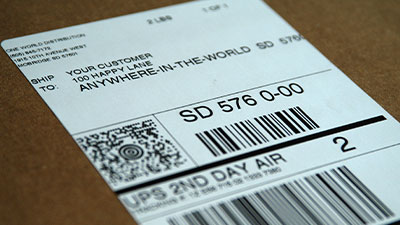Ecommerce brands looking to increase sales and lower logistics costs can rely on numerous tactics, including ecommerce personalization or outsourcing fulfillment services. International shipping is another great way to increase sales, but the process can be very intimidating. OWD strives to alleviate the stigma around international shipping for our clients, especially during frantic ecommerce periods, such as peak season.
International shipping and fulfillment are essential for any ecommerce business looking to tap into the global market. For ecommerce sellers, navigating these complexities can be daunting but incredibly rewarding. Having the right fulfillment partner to handle international shipping ensures timely deliveries, enhances customer satisfaction, and builds brand loyalty.
However, several challenges are associated with online shopping, such as managing shipping costs, handling returns, or dealing with customs compliance. This guide will give you the full rundown on starting and thriving with global ecommerce, helping you streamline your operations and seize new market opportunities.
International Shipping and Fulfillment is the process of transporting goods across borders and ensuring they reach the end customers in various countries. This involves handling logistics, customs documentation, and efficient delivery mechanisms to ensure timely and cost-effective operations.
Fulfillment centers are crucial hubs in the international logistics network, responsible for storing inventory, processing orders, packaging products, and managing returns. These centers enable businesses to position their products closer to end customers, significantly reducing shipping times and costs. For instance, a logistics partner with a fulfillment center in Amsterdam can strategically distribute products throughout Europe, enhancing delivery efficiency.
Beyond just storage and processing, fulfillment centers are integral to the last-mile delivery process. They ensure that packages reach the final destination—the customer’s address—by coordinating with local carriers or postal services. An international distribution center equipped with advanced technology further streamlines operations by integrating with various ecommerce platforms and automating workflows, ensuring a seamless fulfillment process from start to finish.
This combination highlights how fulfillment centers not only manage inventory and order processing but also play a vital role in ensuring efficient last-mile delivery, ultimately improving the overall customer experience.
Understanding these components allows businesses to streamline their global fulfillment services, ensuring they can meet customer expectations across different markets.
Global ecommerce fulfillment centers can be a comprehensive solution for managing every aspect of international shipping and logistics for ecommerce sellers. These services encompass everything from warehousing and inventory management to order processing, picking and packaging, and final delivery to the customer. By leveraging an international 3PL, businesses can streamline their fulfillment strategy and focus on core business activities.
Cost reduction in international shipping is crucial for your ecommerce business. Factors influencing shipping costs include:
Customs duties and tariffs are taxes levied on imported goods. These charges vary by country and product type and directly impact your bottom line.
A dependable 3PL partner like One World Direct (OWD) offers tailored solutions to mitigate shipping costs and customs duties:
By understanding the factors driving shipping costs and effectively managing customs duties, you position your business for global success while maintaining a competitive edge in pricing.
Proper customs compliance is essential to avoid delays or penalties during the international shipping process. A meticulous approach to documentation ensures your shipments move seamlessly through customs, safeguarding your customer satisfaction and brand reputation.
Adhering to these practices enhances the likelihood of smooth international deliveries and minimizes disruptions that could impact your global operations.
Understanding and overcoming international regulations and shipping limitations is crucial for successful global fulfillment. Different countries have their own rules and restrictions that can greatly affect your shipping plans.
Leveraging technology is critical to maintaining an efficient and reliable international shipping strategy. Advanced tools streamline processes and enhance accuracy and customer satisfaction.
In addition to these technological advancements, ecommerce personalization is becoming increasingly important in enhancing customer experience. Offering product customization options can significantly boost sales by catering to individual customer preferences. OWD offers personalized-to-consumer (P2C) fulfillment services for easy product personalization. Shoppers can customize products online with personalized engravings, embroidery, or direct-to-object printing. You can also customize packaging and include personalized greeting cards in orders.
Effective packaging design plays a crucial role in international shipping strategy. It needs to strike a balance between protecting products during transit and minimizing costs. Here’s how you can achieve that:
Implementing these practices ensures your packaging is cost-effective while maintaining product integrity. Leveraging real-time inventory management software helps monitor stock levels and streamline packaging processes. This software provides insights into which packaging sizes are most frequently used, allowing for bulk purchasing and further cost savings. Also, using kitting services, batch picking, and other picking techniques can help lower expenses.
The COVID-19 pandemic has fundamentally changed how consumers behave and how logistics networks operate, forcing businesses to rethink their international shipping strategy. Ecommerce saw an unprecedented increase as consumers shifted to online shopping, leading to a higher demand for efficient and reliable global fulfillment operations.
Exploring new markets for business growth requires a comprehensive approach. Identifying untapped markets where your products have high demand potential is critical. Start by analyzing market data and trends to uncover regions with increasing consumer interest in your product category. Utilize tools like Google Trends, industry reports, and local market research to pinpoint these opportunities.
Compliance with local regulations is non-negotiable when entering new markets. Each country has its own set of rules governing imports, product standards, and marketing practices.
Navigating the complexities of international order fulfillment presents several common challenges for businesses. These can significantly impact efficiency, cost, and customer satisfaction if not addressed properly.
By proactively addressing these challenges with strategic planning and leveraging technology solutions, you can streamline your international fulfillment operations and enhance your global reach.
Starting to sell internationally can seem daunting, but with OWD’s expertise, the process becomes straightforward. Here’s a quick guide:
Since 1994, OWD has made international shipping less intimidating and more accessible, so you can focus on growing your business globally.
When it comes to mastering the complexities of international shipping, One World Direct (OWD) stands out. A major carrier representative recently shared insights on OWD’s expertise:
"In my years working with various third-party logistics providers, One World Direct consistently demonstrates a superior proficiency in handling complex international shipments. Their ability to navigate intricate customs regulations and deliver timely, cost-effective solutions is unmatched."
Additionally, OWD can help with other crucial aspects of running an ecommerce business, including reverse logistics, lot management, and ecommerce customer service. Book a logistics consultation to learn more about a partnership and extending into international markets.
We offer comprehensive customs compliance support, including automated commercial invoices, DDP (Delivered Duty Paid) services, and proactive customs resolution if issues arise. Our team ensures accurate documentation and classification to facilitate smooth international deliveries, minimizing delays and compliance risks.
We offer flat rate shipping which provides clear visibility into all shipping costs and surcharges upfront, enabling you to make informed decisions and avoid unexpected expenses.Our international shipping channels include DDU and DDP options, you choose what works best for your brand.
Yes, OWD provides over 200 ecommerce integrations, connecting seamlessly with shopping carts, marketplaces, and ERPs. We also support EDI integrations through our open API. This allows for smooth multi-channel distribution and makes it easier for you to manage your sales across various platforms
Delivery times vary based on how far the package is traveling. However, with flexible shipping options, we ensure rapid delivery times while maintaining cost-efficiency.
Absolutely! We offer dedicated call center services that can handle your calls, chats, and emails on your behalf, ensuring that your customers receive timely assistance with their inquiries.
We understand that managing ecommerce return rates can be challenging, especially in international shipping. Our experienced team is equipped to handle these returns efficiently, ensuring a smooth process for both you and your customers.
Yes, we provide tailored solutions for both B2B and B2C logistics, adapting our services to meet the specific requirements of each business model.
International shipping and fulfillment refer to the processes involved in delivering goods across international borders. This includes the logistics of transporting products from a seller to customers in different countries and managing the necessary customs documentation and compliance.
Global ecommerce fulfillment services offer numerous advantages for ecommerce businesses, such as faster delivery times, improved customer satisfaction, and access to international markets.
Shipping costs are influenced by factors such as package dimensions and weight. Understanding customs duties and tariffs is crucial, and working with a reliable third-party logistics (3PL) partner can help minimize these expenses through effective strategies.
Proper customs documentation is essential to avoid delays or penalties. Common documents include commercial invoices, packing lists, and any specific forms required by the destination country to ensure smooth international deliveries.
Common challenges in international order fulfillment include regulatory issues, unexpected delivery delays, and navigating shipping restrictions imposed by various countries. Being aware of these challenges can help businesses develop strategies to overcome them effectively.
The COVID-19 pandemic has reshaped consumer behavior and logistics networks worldwide. Businesses need to adapt their international fulfillment processes accordingly, considering changes in demand patterns and potential disruptions in supply chains.
Start by doing a Google search for the customs website for the specific countries you want to ship to. Each country’s site will have a list of restricted items.
Value-Added Tax, commonly known as VAT, is a consumption tax charged to retailers when they sell a product or service. Most ecommerce sellers will either bake this tax into the value of their items or charge this tax back to their customer as an additional line in the shopping cart at the checkout process. VAT is comparable to sales tax in the U.S. It differs from country to country, so it is important that you research the VAT guidelines for any countries you plan to ship to.
HTS stands for Harmonized Tariff Schedule. HTS Codes were developed in order to streamline the classification of goods that are traded internationally. You can look up the HTS Code for your product on the United States International Trade Commission website; https://hts.usitc.gov/.
Automated Export System Codes, or AES Codes, are required for international shipments valued over $2,500 USD. AES is a joint venture between several different federal agencies and the export trade community, and it is the central point through which export shipment data required by multiple agencies is filed electronically to Customs and Border Protection (CPB). If your international order is valued over $2,500, it will automatically go on hold in OWD’s system so your Fulfillment Specialist can obtain an AES Code. Your FS will submit all necessary information about that order to the US CBP. When all information is submitted your FS will be emailed the AES Code so it can be attached to the order. The order can then be released to ship and should not have any delays at customs.
The country you are shipping to will charge a tax/duty, which is typically based on the value of the package you are sending. These duties can either be paid by the recipient, or by the individual that is purchasing the item(s).
DDU stands for Delivery Duty Unpaid: Customs will contact the receiver to collect the duties and taxes before the shipment is delivered.
DDP stands for Delivery Duty Paid: The sender pays the duties and taxes, which are included in the cart at checkout.
A commercial invoice is a customs document that declares the true value of an item. Customs uses this document to assess taxes and duties on your international shipment. OWD will automatically generate a commercial invoice and attach it to each carton for every international shipment. We will also send an electronic commercial invoice to any countries that accept them.
OWD requires any SKU that ships internationally to have a customs value and customs description associated with it. This information is provided by our clients and can be updated if the description or price of your item changes. The customs value and description entered under each SKU will automatically upload on the commercial invoice.
No. The value of your items must be consistent across all orders and must be entered as a realistic value. Customs reserves the right to hold any shipments with values that are not realistic. The value can be listed below the sale price or at a discount from the actual amount the customer paid for the item. However, the amount specified is the maximum amount the carrier is liable for should damages or loss occur.
Customs will contact the shipper letting them know the reason the package is stuck. You will have a set amount of time to provide customs with the information they need (it may be an address, phone number, item description/cost, etc.). If customs doesn’t receive the information they need before the deadline, the package is returned to the sender at your expense.

Fulfillment costs are based on three criteria: size, weight and delivery time.
OWD offers five service levels: economy (7-10 days); Standard (5-7 days), 2-Day, Overnight and International.

Example Weight: 1 ounce
Fulfillment | Postage | Total |
|---|---|---|
$1.75 | $3.64 | $5.39 |
Lorem ipsum dolor sit amet, consectetur adipiscing elit. Ut elit tellus, luctus nec ullamcorper mattis, pulvinar dapibus leo.
Lorem ipsum dolor sit amet, consectetur adipiscing elit. Ut elit tellus, luctus nec ullamcorper mattis, pulvinar dapibus leo.
Lorem ipsum dolor sit amet, consectetur adipiscing elit. Ut elit tellus, luctus nec ullamcorper mattis, pulvinar dapibus leo.
Lorem ipsum dolor sit amet, consectetur adipiscing elit. Ut elit tellus, luctus nec ullamcorper mattis, pulvinar dapibus leo.
Lorem ipsum dolor sit amet, consectetur adipiscing elit. Ut elit tellus, luctus nec ullamcorper mattis, pulvinar dapibus leo.
DDU means Delivery Duty Unpaid – where the buyer pays for all of the import fees at delivery.
Unexpected import fees give buyers sticker shock – not good. When they refuse to pay, you’ve lost a sale and must pay to return your product, or abandon it.
DDU is an old idea whose time has passed. For these reasons and more, OWD doesn’t recommend DDU for e-com sellers.
DDP is an acronym for Delivery Duty Paid. DDP means that the seller pays for all the duties and import fees.
With DDP, your customers won’t be surprised with unexpected customs charges – good!
With OWD’s landed cost calculator, your foreign customers will know exactly what their various VAT, customers and duties will cost. No unhappy surprises.
For large-scale operations needing a full solution in Europe, there’s OWD Europe, based in Amsterdam.

OWD handles phone calls, e-mails and web chat eighteen hours a day from our own state-of-the-art facility.
We’ll handle your inbound sales and customer service contacts.
You get career agents who speak American English and know how to sell.
$99 gets you 200 calls, e-mails or chats handled every week.
You get your own phone number and custom e-mail.
We do a lot more. Call for details.

The Voice of Your Brand
OWD’s all-inclusive Returns service provides simplicity and high-end customer service. OWD includes a pre-printed return label as part of your packing slip. Your customer need only drop it in the mail.
What’s included: packaging slip with return label, QC inspection, re-bag, re-tag and return to stock. What’s excluded: postage cost, poly bags and any special packaging.
